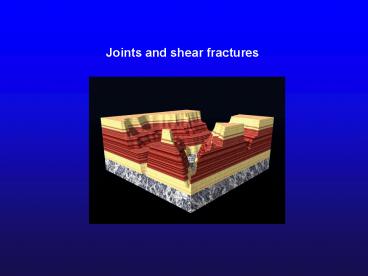Joints and shear fractures - PowerPoint PPT Presentation
1 / 36
Title:
Joints and shear fractures
Description:
Joints and shear fractures. Announcements. Need two HOV drivers for ... Moscow Kremlin - Bell Tower of Ivan the Great. Fractured in 1737 due to uneven cooling ... – PowerPoint PPT presentation
Number of Views:305
Avg rating:3.0/5.0
Title: Joints and shear fractures
1
Joints and shear fractures
2
Announcements
- Need two HOV drivers for Sat field trip
- Extra credit
- Talk to Al Pullen asap
3
Structural Analysis Approach
- Geometry mapping, measurements of orientations
- Kinematics motions related to deformation
- Translation change in position
- Rotation change in orientation
- Distortion change in shape
- Dilation change in volume
Dynamics/Mechanics relating deformation to
stresses
4
What is it??
Marker bed
5
Structures from shallow to deep in the crust,
beginning with. Joints (D R p.
205-226) Next lecture Faults (DR p.269-279
286-296)
6
Types of joints
- Opening (mode 1)
- Shearing (mode 2)
- Scissoring (mode 3)
Can be filled with veins materials (calcite,
quartz), Form networks that is preferentially
oriented in the regional stress field
7
- Joint A fracture that forms by tensile loading
- walls of fracture move apart slightly no
appreciable displacement - forms perpendicular to tensile direction
- abundant structural element
8
Joint A fracture that forms by tensile loading-
walls of fracture move apart slightly as joint
develops form perpendicular to tensile
direction abundant structural element
9
Joint arrays
10
Joints in 3-D commonly elliptical
11
Joint surfaces
- Planar and often smooth, but not that smooth...
Some texture
Moscow Kremlin - Bell Tower of Ivan the Great.
Fractured in 1737 due to uneven cooling
12
Origin analogous to the focus of an earthquake
Plumose structure A subtle roughness on surface
of some joints resembles imprint of a feather.
13
hackles in plumose structure.
14
Joints Kinematics
ribs are arrest lines- opening is not
instantaneous, but rhythmic, like splitting wood
(ripping paper analogy)
15
- GEOMETRY- planar, plumose structure
- KINEMATICS- very small pull-apart movements
(dilation) - ON TO MECHANICS...
16
Griffith crack theory pre-existing microcracks
in a rock- act as stress "concentrators"
The largest properly oriented Griffith cracks
(perpendicular to tensile direction) propagate to
form a through-going crack
17
But what produces the tensile stress?
18
Thermal contraction can produce joints
19
REMOVAL OF OVERLYING ROCKS (unloading) PRODUCES
JOINTS!
Unloading joints due to removal of overburden--
rock expands in vertical direction and contracts
in horizontal direction ("Poisson effect")
(marshmallow analogy) - forms near vertical and
horizontal joint arrays
20
Jointing in response to unloading and "residual
stresses"
21
Exfoliation joints Are parallel to topography
form by unloading of "residual" stress
22
WHY ARE JOINTS IMPORTANT?
Joints related to regional stress
23
Can also tell us about orientation of tectonic
stress
Can strongly influence the landscape weathering
is localized along joint surfaces-- hoodoos
24
(No Transcript)
25
(No Transcript)
26
(No Transcript)
27
Significance for Engineering Planes of
weakness! Rock bursts in mines.
Significance for petroleum pathways for
hydrocarbons pump water into ground to
artificially produce joints! (hydrofracturing)
28
Significance Economic Geology Alteration/Minerali
zation along fractures Veins preserve dilational
separation
29
Geologic Hazards Rockbursts in mines
30
Joints form/occur mainly in the uppermost crust
(upper few kilometers) WHY?
Stresses become more compressive with depth to
the point where rocks cant pull-apart
31
Shear fracture A fracture with a component of
sliding motion due to compression
32
Determining the sense of shear
33
Shear fractures with appreciable displacements
FAULTS
34
Shear fractures
en echelon tension gashes -form 45 degrees from
plane of max. shear stress -preexisting vein
material rotates while new vein material grows
35
(No Transcript)
36
Next Geometry and Kinematics Faults (Read
DR, p. 269-279 286-296)































